Characterization of Volatile Organic Compounds of Healthy and Huanglongbing-Infected Navel Orange and Pomelo Leaves by HS-GC-IMS
Abstract
:1. Introduction
2. Results and Discussion
2.1. HS-GC-IMS Topographic Plots of HEAO, HLBO, HEAP, and HLBP
2.2. Differences in the Characteristic Volatile Fingerprints of HEAO, HLBO, HEAP, and HLBP
2.3. Identification of Volatile Organic Compounds in HEAO, HLBO, HEAP, and HLBP
2.4. Similarity Analysis of Fingerprint Based on PCA
3. Materials and Methods
3.1. Materials
3.2. GC-IMS Analyses
3.2.1. Apparatuses
3.2.2. HS-GC-IMS Analysis Methods
3.3. Statistical Analysis
4. Conclusions
Author Contributions
Funding
Acknowledgments
Conflicts of Interest
References
- Wang, N.; Pierson, E.A.; Setubal, J.C.; Xu, J.; Levy, J.G.; Zhang, Y.; Li, J.; Rangel, L.T.; Martins, J.J. The Candidatus liberibacter-host interface: Insights into pathogenesis mechanisms and disease control. Annu. Rev. Phytopathol. 2017, 55, 451–482. [Google Scholar] [CrossRef]
- Singerman, A. The Real Cost of HLB in Florida. Citrus Ind. 2019, 2019, 10–13. [Google Scholar]
- Rao, M.J.; Ding, F.; Wang, N.; Deng, X.; Xu, Q. Metabolic Mechanisms of Host Species against Citrus Huanglongbing (Greening Disease). Crit. Rev. Plant Sci. 2019, 37, 496–511. [Google Scholar] [CrossRef]
- Xu, B.M.; Baker, G.L.; Sarnoski, P.J.; Goodrich-Schneider, R.M. A Comparison of the Volatile Components of Cold Pressed Hamlin and Valencia (Citrus sinensis (L.) Osbeck) Orange Oils Affected by Huanglongbing. J. Food Qual. 2017, 2017, 6793986. [Google Scholar] [CrossRef]
- Yan, H.; Zeng, J.; Zhong, G. The push-pull strategy for citrus psyllid control. Pest Manag. Sci. 2015, 71, 893–896. [Google Scholar] [CrossRef] [PubMed]
- Patt, J.; Sétamou, M. Responses of the Asian citrus psyllid to volatiles emitted by the flushing shoots of its rutaceous host plants. Environ. Entomol. 2010, 39, 618–624. [Google Scholar] [CrossRef] [PubMed] [Green Version]
- Mann, R.S.; Ali, J.G.; Hermann, S.L.; Tiwari, S.; Pelz-Stelinski, K.S.; Hans, T.; Alborn, H.T.; Stelinski, L.L. Induced release of a plant-defense volatile “deceptively” attracts insect vectors to plants infected with a bacterial pathogen. PLoS Pathog. 2012, 8, e1002610. [Google Scholar] [CrossRef] [PubMed] [Green Version]
- Wenninger, E.J.; Stelinski, L.L.; Hall, D.G. Role of olfactory cues, visual cues, and mating status in orientation of Diaphorina citri Kuwayama (Hemiptera: Psyllidae) to four different host-plants. Environ. Entomol. 2009, 38, 225–234. [Google Scholar] [CrossRef] [Green Version]
- Robbins, P.S.; Alessandro, R.T.; Stelinski, L.L.; Lapointe, S.L. Volatile profiles of young leaves of Rutaceae spp. Varying in susceptibility to the Asian citrus psyllid (Hemiptera: Psyllidae). Fla. Entomol. 2012, 95, 774–776. [Google Scholar] [CrossRef]
- Alquézar, B.; Volpe, H.X.L.; Magnani, R.F.; Miranda, M.P.D.; Santos, M.A.; Wulff, N.A.; Bento, J.M.S.; Parra, J.R.P.; Bouwmeester, H.; Peňa, L. β-Caryophyllene emitted from a transgenic Arabidopsis or chemical dispenser repels Diaphorina citri, vector of Candidatus Liberibacters. Sci. Rep. 2017, 7, 5639. [Google Scholar] [CrossRef]
- Andrade, M.D.S.; Ribeiro, L.d.P.; Borgoni, P.C.; da Silva, M.F.; Forim, M.R.; Fernandes, J.B.; Vieira, J.D.; Vendramin, J.D.; Machado, M.A. Essential oil variation from twenty two genotypes of Citrus in Brazil–chemometric approach and repellency against Diaphorina citri Kuwayama. Molecules 2016, 21, 814. [Google Scholar] [CrossRef]
- Chen, H.; Palmer, I.A.; Chen, J.; Chang, M.; Thompson, S.L.; Liu, L.; Fu, Z. Specific and Accurate Detection of the Citrus Greening Pathogen Candidatus liberibacter spp. Using Conventional PCR on Citrus Leaf Tissue Samples. J. Vis. Exp. 2018, 136, e57240. [Google Scholar] [CrossRef] [PubMed]
- Iftikhar, Y.; Rauf, S.; Shahzad, U.; Zahid, M.A. Huanglongbing: Pathogen detection system for integrated disease management—A review. J. Saudi Soc. Agric. Sci. 2016, 15, 1–11. [Google Scholar] [CrossRef] [Green Version]
- Mendoza-Peña, E.; Cibrián-Tovar, J.; Velázquez-González, J.; Tafoya-Rangel, F.; Azuara-Domínguez, F. Volatile compounds of Persian and Mexican lime associated with HLB (Huanglongbing) symptoms. Rev. Colomb. Entomol. 2018, 44, 19–24. [Google Scholar] [CrossRef] [Green Version]
- Aksenov, A.A.; Martini, X.; Zhao, W.; Stelinski, L.L.; Davis, C.E. Synthetic blends of volatile, phytopathogen-induced odorants can be used to manipulate vector behavior. Front. Ecol. Evol. 2014, 2, 1–9. [Google Scholar] [CrossRef] [Green Version]
- Wang, H.; Ramnani, P.; Pham, T.; Villarreal, C.C.; Yu, X.; Liu, J.; Mulchandani, A. Gas Biosensor Arrays Based on Single-Stranded DNA-Functionalized Single-Walled Carbon Nanotubes for the Detection of Volatile Organic Compound Biomarkers Released by Huanglongbing Disease-Infected Citrus Trees. Sensors 2019, 19, 4795. [Google Scholar] [CrossRef] [Green Version]
- Aksenov, A.A.; Pasamontes, A.; Peirano, D.J.; Zhao, W.; Dandekar, A.M.; Fiehn, O.; Ehsani, R.; Davis, C.E. Detection of Huanglongbing disease using differential mobility spectrometry. Anal. Chem. 2014, 86, 2481–2488. [Google Scholar] [CrossRef]
- U.S. Department of Agriculture (USDA). Citrus: World Markets and Trade. Available online: http://apps.fas.usda.gov/psdonline/circulars/citrus.pdf (accessed on 27 July 2020).
- Zhang, L.; Geng, Y.; Zhu, H.; Mu, Y.; Yu, J.; Li, J.; Wang, X. Preparative separation of six coumarins from the pummelo (Citrus maxima (Burm.) Merr. Cv. Shatian Yu) peel by high-speed countercurrent chromatography. J. Liq. Chromatogr. Relat. Technol. 2017, 40, 991–996. [Google Scholar] [CrossRef]
- Riu-Aumatell, M.; Vargas, L.; Vichi, S.; Guadayol, J.M.; López-Tamames, E.; Buxaderas, S. Characterisation of volatile composition of white salsify (Tragopogon porrifolius L.) by headspace solid-phase microextraction (HS-SPME) and simultaneous distillation–extraction (SDE) coupled to GC-MS. Food Chem. 2011, 129, 557–564. [Google Scholar] [CrossRef]
- Peng, F.; Sheng, L.; Liu, B.; Tong, H.; Liu, S. Comparison of different extraction methods: Steam distillation, simultaneous distillation and extraction and headspace co-distillation, used for the analysis of the volatile components in aged flue-cured tobacco leaves. J. Chromatogr. A 2004, 1040, 1–17. [Google Scholar] [CrossRef]
- Pourmortazavi, S.M.; Hajimirsadeghi, S.S. Supercritical fluid extraction in plant essential and volatile oil analysis. J. Chromatogr. A 2007, 1163, 2–24. [Google Scholar] [CrossRef]
- Wang, Z.; Gao, C.; Liu, J.; Zhou, W.; Zeng, X. Host plant odours and their recognition by the odourant-binding proteins of Diaphorina citri Kuwayama (Hemiptera: Psyllidae). Pest Manag. Sci. 2020, 76, 2453–2464. [Google Scholar] [CrossRef]
- Sharma, R.; Zhou, M.; Hunter, M.D.; Fan, X. Rapid In Situ Analysis of Plant Emission for Disease Diagnosis Using a Portable Gas Chromatography Device. J. Agric. Food Chem. 2019, 67, 7530–7537. [Google Scholar] [CrossRef]
- Hernández-Mesa, M.; Ropartz, D.; García-Campaña, A.M.; Rogniaux, M.; Dervilly-Pinel, G.; Bizec, B.L. Ion Mobility Spectrometry in Food Analysis: Principles, Current Applications and Future Trends. Molecules 2019, 24, 2706. [Google Scholar] [CrossRef] [Green Version]
- Kafle, G.K.; Khot, L.R.; Sankaran, S.; Bahlol, H.Y.; Tufariello, J.A.; Hill, H.H. State of ion mobility spectrometry and applications in agriculture: A review. Eng. Agric. Environ. Food 2016, 9, 346–357. [Google Scholar] [CrossRef]
- Yang, L.; Liu, J.; Wang, X.; Wang, X.; Ren, F.; Zhang, Q.; Shan, Y.; Ding, S. Characterization of Volatile Component Changes in Jujube Fruits during Cold Storage by Using Headspace-Gas Chromatography-Ion Mobility Spectrometry. Molecules 2019, 24, 3904. [Google Scholar] [CrossRef] [Green Version]
- Hu, X.; Wang, R.; Guo, J.; Ge, K.; Li, G.; Fu, F.; Ding, S.; Shan, Y. Changes in the Volatile Components of Candied Kumquats in Different Processing Methodologies with Headspace–Gas Chromatography–Ion Mobility Spectrometry. Molecules 2019, 24, 3053. [Google Scholar] [CrossRef] [Green Version]
- Rodríguez-Maecker, R.; Vyhmeister, E.; Meisen, S.; Martinez, A.R.; Kuklya, A.; Telgheder, U. Identification of terpenes and essential oils by means of static headspace gas chromatography–ion mobility spectrometry. Anal. Bioanal. Chem. 2017, 409, 6595–6603. [Google Scholar] [CrossRef]
- Sebzalli, Y.; Wang, X. Knowledge discovery from process operational data using PCA and fuzzy clustering. Eng. Appl. Artif. Intell. 2001, 14, 607–616. [Google Scholar] [CrossRef]
- Materic, D.; Bruhn, D.; Turner, C.; Morgan, G.; Mason, N.; Gauci, V. Methods in plant foliar volatile organic compounds research. Appl. Plant Sci. 2015, 3, 1500044. [Google Scholar] [CrossRef]
- Kessler, A.; Baldwin, I.T. Defensive function of herbivore induced plant volatile emissions in nature. Science 2001, 291, 2141–2144. [Google Scholar] [CrossRef] [PubMed]
- Heil, M.; Silva Bueno, J.C. Within-plant signaling by volatiles leads to induction and priming of an indirect plant defense in nature. Proc. Natl. Acad. Sci. USA 2007, 104, 5467–5472. [Google Scholar] [CrossRef] [PubMed] [Green Version]
- Kessler, A.; Kalske, A. Plant secondary metabolite diversity and species interactions. Annu. Rev. Ecol. Evol. Syst. 2018, 49, 115–138. [Google Scholar] [CrossRef]
Sample Availability: Samples of Gannan Newhall navel orange leaves (HEAO and HLBO) and Shatian pomelo leaves (HEAP and HLBP) are available from the authors. |
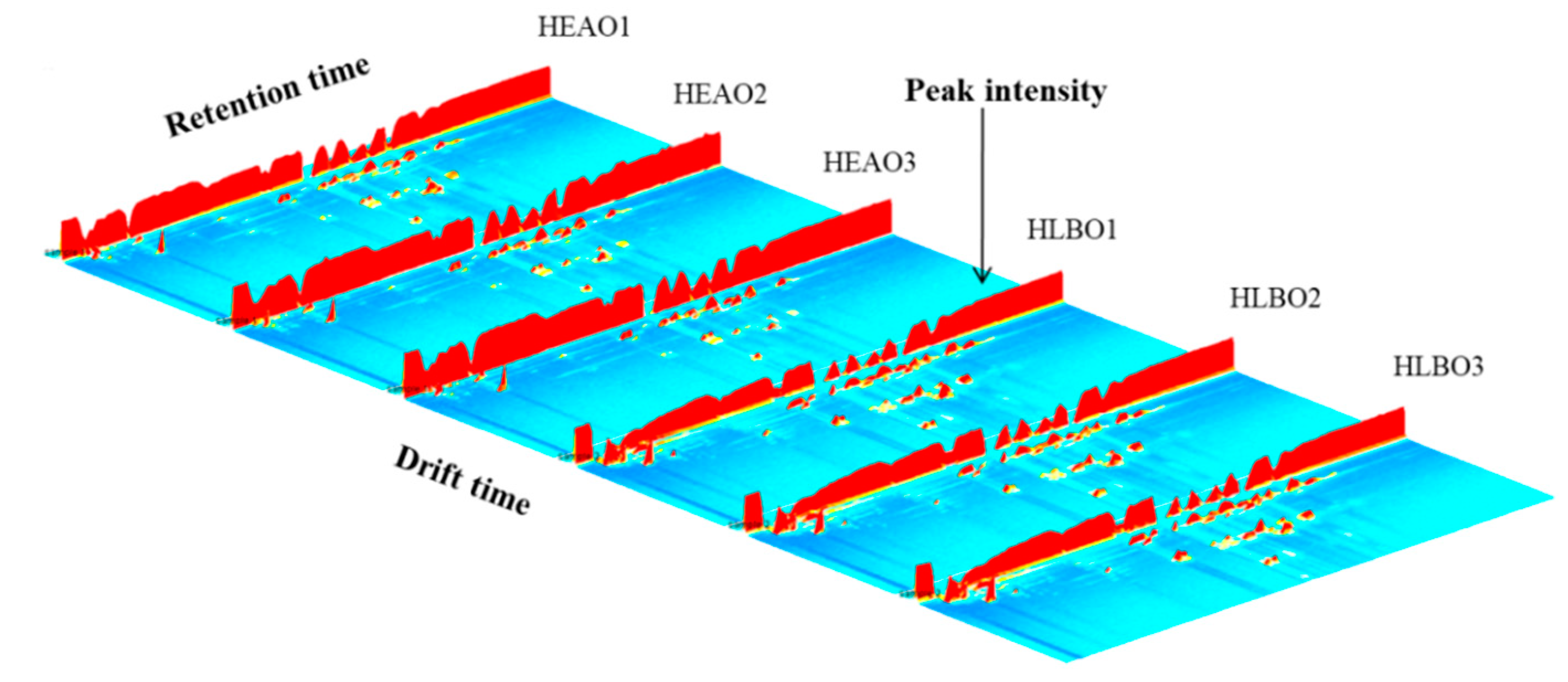

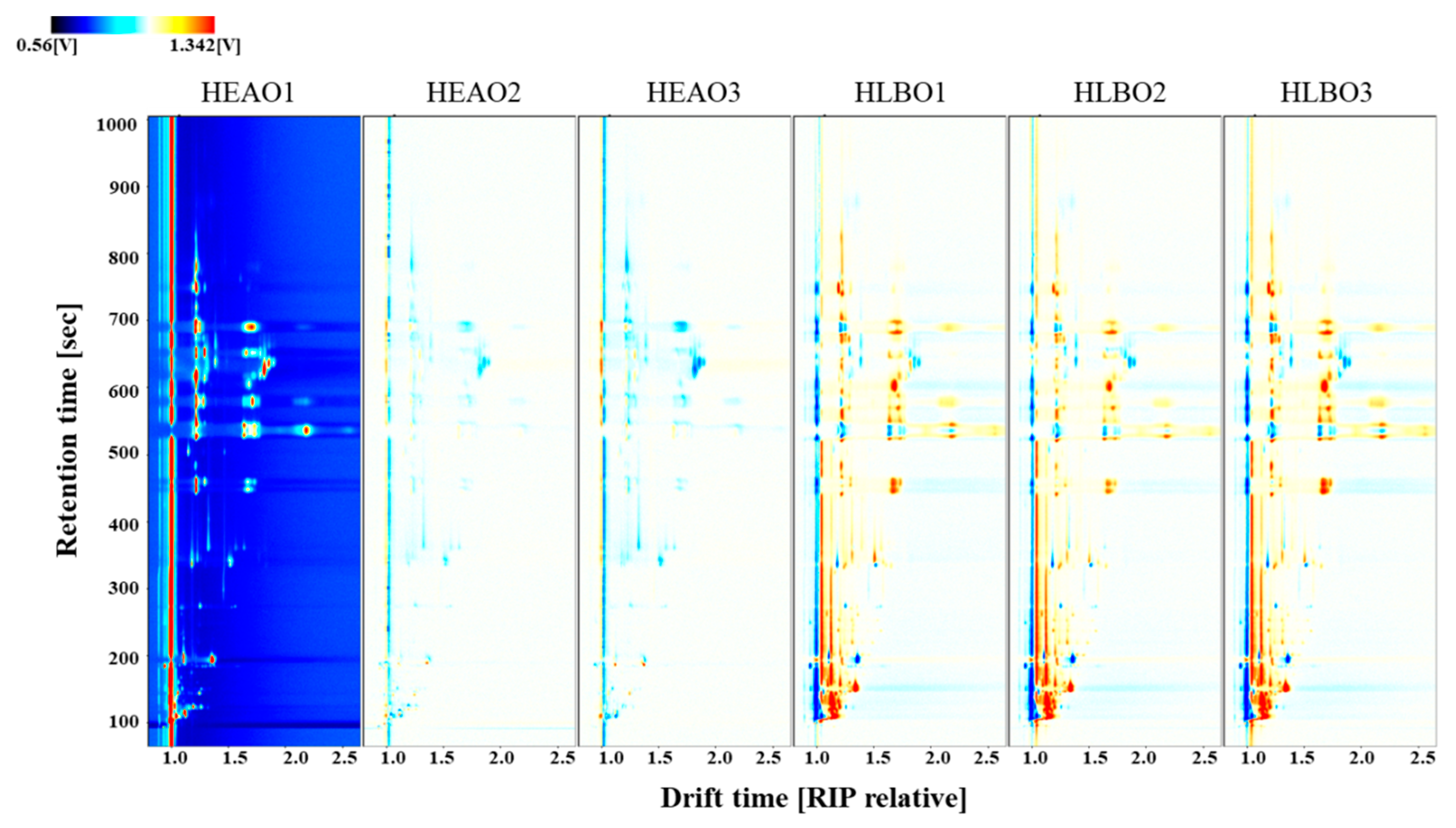
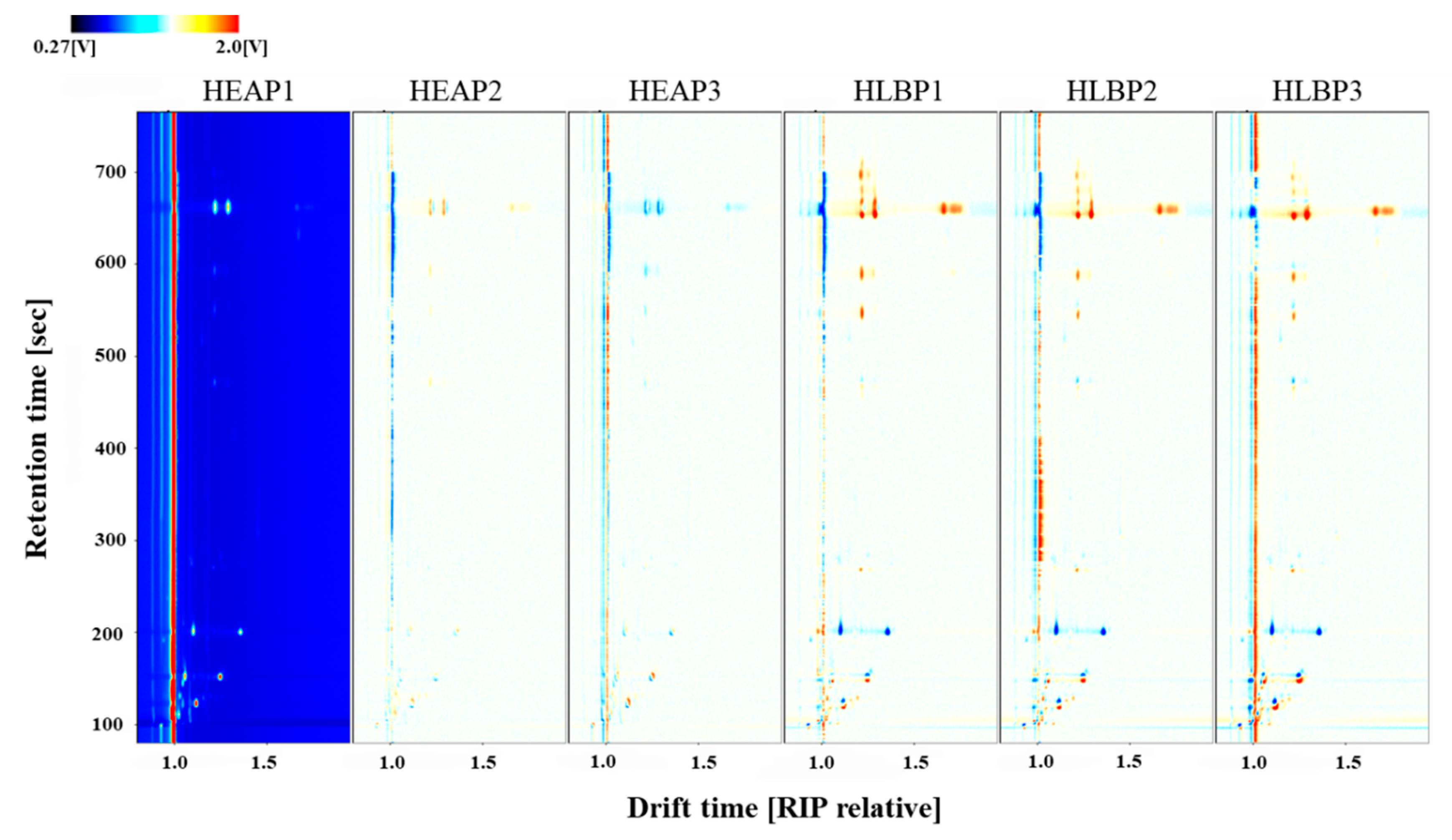
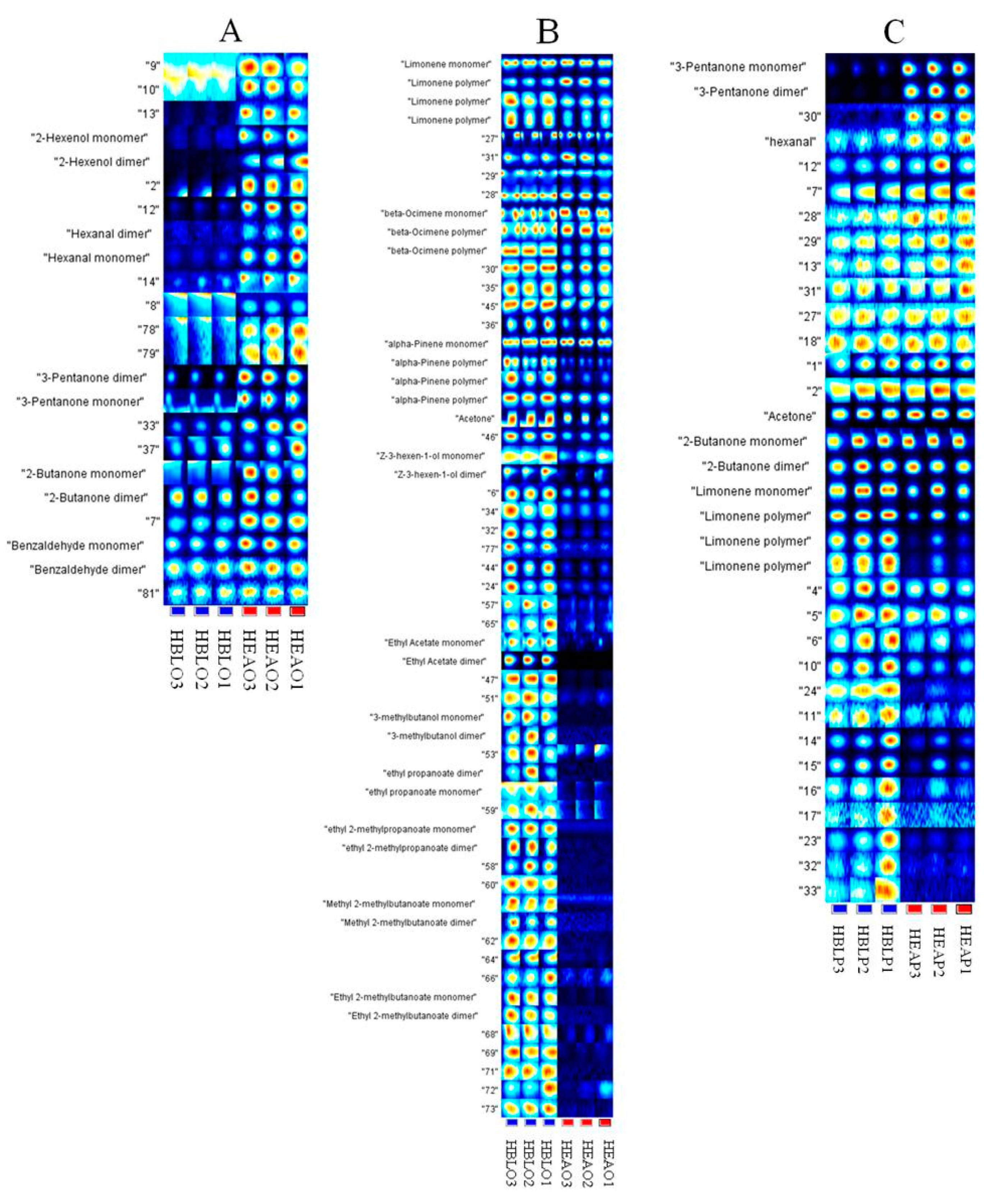

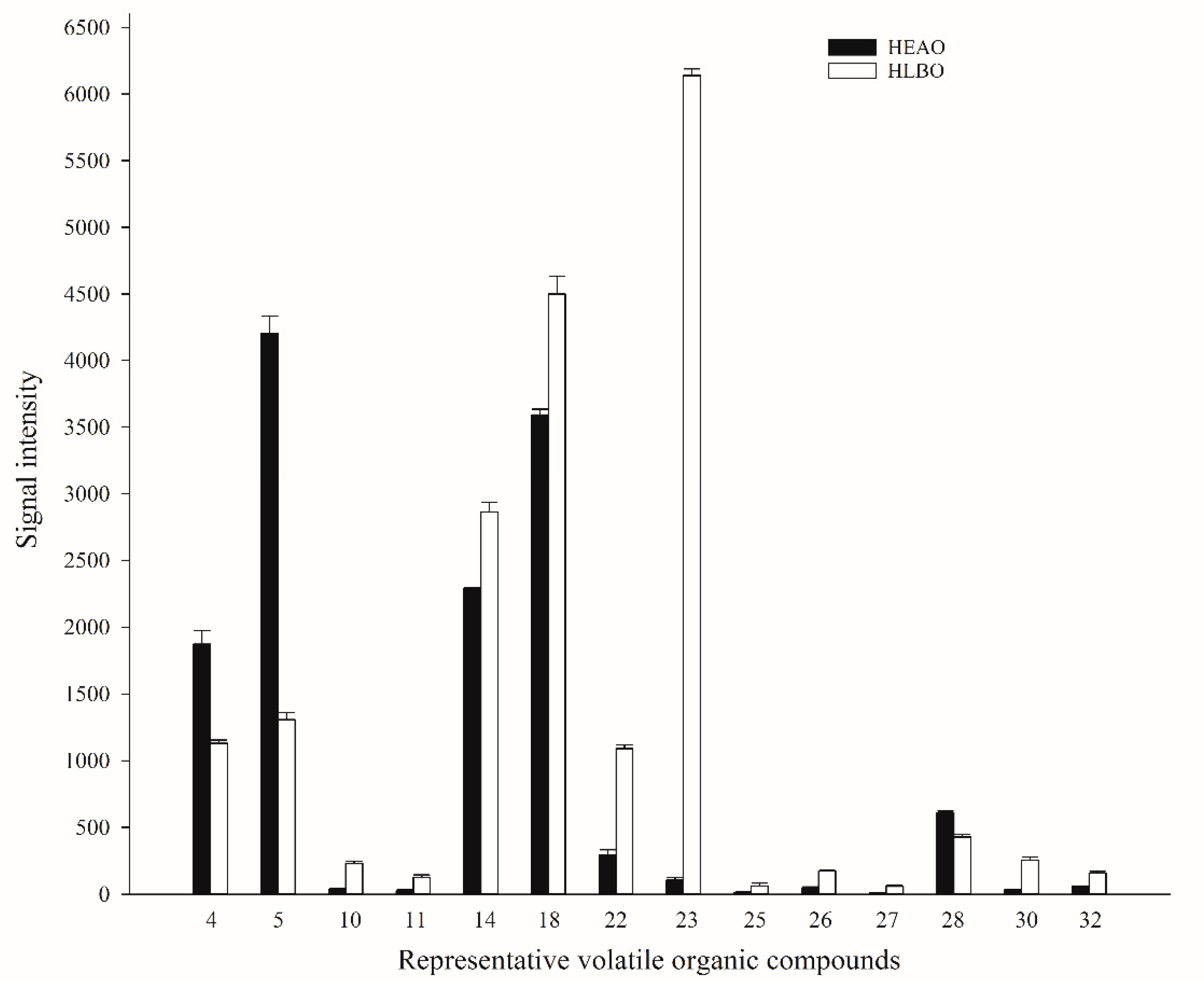

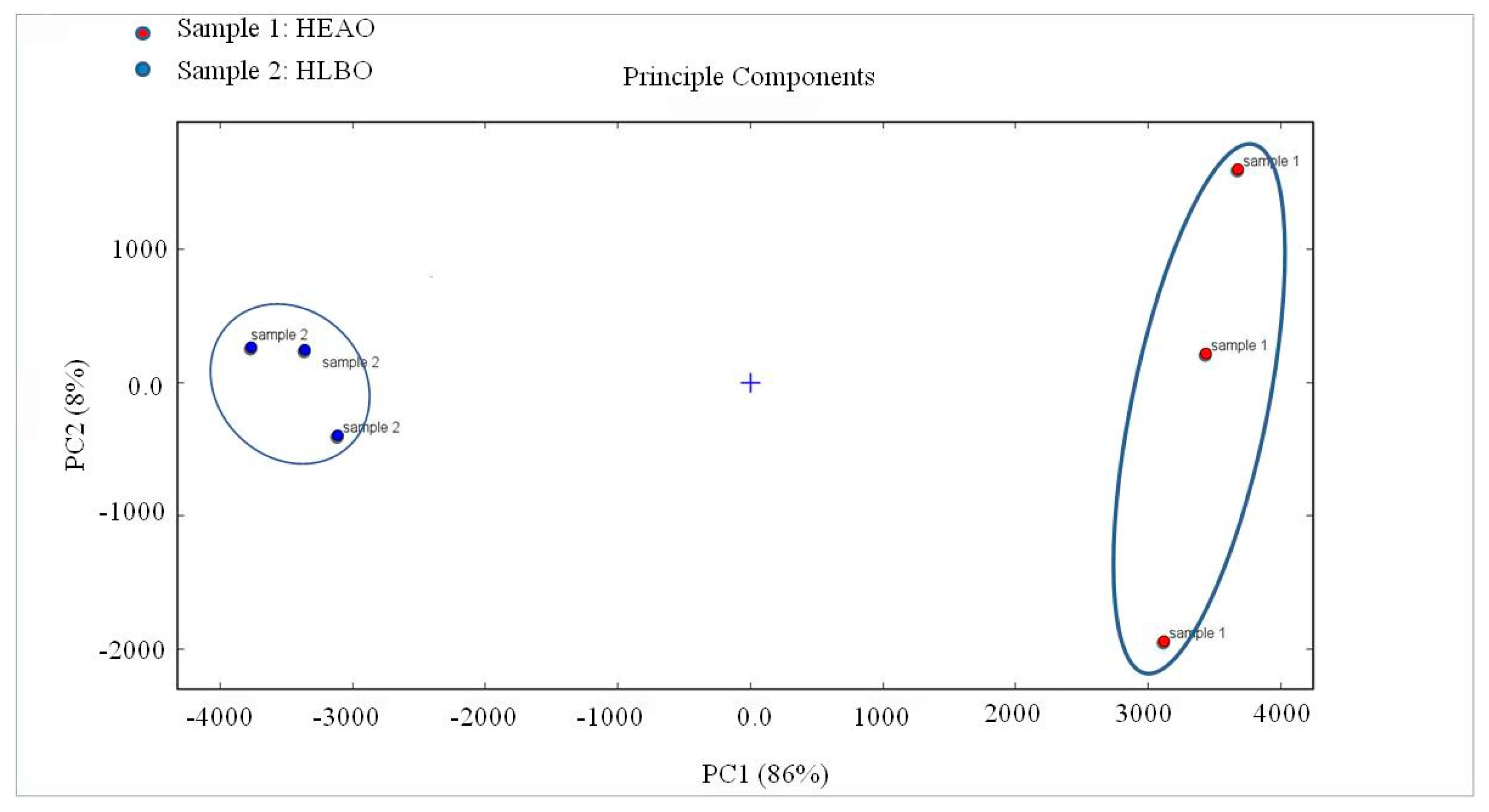

| NO. | Compound | RI a | Rt b (s) | Dt c (RIP d Relative) | Signal Intensity(HEAO) | Signal Intensity(HLBO) | P Value | Difference |
|---|---|---|---|---|---|---|---|---|
| 1 | Acetone | 527.0 | 116.749 | 1.1172 | 2181.6 ± 48.5 | 4403.7 ± 96.3 | <0.001 | −101.9% |
| 2 | 2-Butanone | 604.3 | 145.839 | 1.0579 | 731.7 ± 89.3 | 481.9 ± 12.0 | 0.009 | 34.1% |
| 3 | 2-Butanone dimer | 601.6 | 144.824 | 1.2477 | 455.2 ± 91.4 | 459.9 ± 34.8 | 0.937 | −1.0% |
| 4 | 3-Pentanone | 702.1 | 195.225 | 1.1063 | 1873.4 ± 100.9 | 1129.3 ± 24.6 | <0.001 | 39.7% |
| 5 | 3-Pentanone dimer | 700.2 | 193.872 | 1.3535 | 4201.6 ± 131.5 | 1307.0 ± 55.1 | <0.001 | 68.9% |
| 6 | Hexanal | 790.6 | 273.363 | 1.2527 | 259.4 ± 43.1 | 79.7 ± 11.7 | 0.002 | 69.3% |
| 7 | Hexanal dimer | 790.7 | 273.385 | 1.5642 | 51.5 ± 15.4 | 24.3 ± 1.9 | 0.039 | 52.8% |
| 8 | 2-Hexenol | 850.6 | 336.576 | 1.1795 | 947.0 ± 99.2 | 288.1 ± 70.8 | 0.001 | 69.6% |
| 9 | 2-Hexenol dimer | 850.2 | 336.033 | 1.5212 | 158.5 ± 45.2 | 24.4 ± 4.9 | 0.035 | 84.6% |
| 10 | Ethyl 2-methylbutanoate | 847.7 | 333.085 | 1.2394 | 32.1 ± 7.2 | 228.1 ± 18.8 | <0.001 | −611.6% |
| 11 | Ethyl 2-methylbutanoate dimer | 848.5 | 334.014 | 1.6553 | 25.7 ± 7.4 | 123.5 ± 21.3 | 0.002 | −380.3% |
| 12 | (Z)−3-Hexen-1-ol | 856.1 | 343.25 | 1.2314 | 189.0 ± 33.3 | 285.5 ± 37.3 | 0.029 | −51.1% |
| 13 | (Z)-3-Hexen-1-ol dimer | 856.1 | 343.204 | 1.512 | 531.2 ± 247.8 | 1457.6 ± 308.6 | 0.015 | −174.4% |
| 14 | Limonene | 1028.8 | 648.135 | 1.2181 | 2292.8 ± 3.8 | 2861.4 ± 73.7 | <0.001 | −24.8% |
| 15 | Limonene polymer | 1031.0 | 652.017 | 1.2961 | 2319.9 ± 190.8 | 1650.0 ± 65.9 | 0.005 | 28.9% |
| 16 | Limonene polymer | 1031.0 | 652.017 | 1.6592 | 1170.7 ± 41.8 | 1841.1 ± 230.1 | 0.008 | −57.3% |
| 17 | Limonene polymer | 1029.9 | 650.076 | 1.7295 | 1296.3 ± 115.4 | 1976.2 ± 276.4 | 0.017 | −52.5% |
| 18 | α-Pinene | 929.7 | 458.139 | 1.2185 | 3590.8 ± 44.2 | 4499.7 ± 133.8 | <0.001 | −25.3% |
| 19 | α-Pinene polymer | 930.0 | 458.63 | 1.2923 | 698.4 ± 12.3 | 1144.4 ± 70.0 | 0.007 | −63.9% |
| 20 | α-Pinene polymer | 927.9 | 454.705 | 1.6744 | 1947.1 ± 150.8 | 5740.3 ± 1061.1 | 0.004 | −194.8% |
| 21 | α-Pinene polymer | 930.2 | 459.12 | 1.7323 | 269.3 ± 31.1 | 808.4 ± 137.0 | 0.003 | −200.2% |
| 22 | Ethyl acetate | 615.6 | 150.24 | 1.0973 | 292.9 ± 39.2 | 1091.6 ± 26.0 | <0.001 | −272.7% |
| 23 | Ethyl acetate dimer | 615.6 | 150.24 | 1.3355 | 105.2 ± 19.4 | 6139.0 ± 49.9 | <0.001 | −5733.5% |
| 24 | Ethyl propanoate | 711.9 | 202.517 | 1.1434 | 69.9 ± 6.4 | 220.5 ± 28.1 | 0.001 | −215.7% |
| 25 | Ethyl propanoate dimer | 710.6 | 201.527 | 1.4548 | 14.3 ± 0.8 | 59.8 ± 22.6 | 0.073 | −317.6% |
| 26 | Ethyl 2-methylpropanoate | 754.3 | 238.813 | 1.1905 | 45.9 ± 9.3 | 172.1 ± 4.6 | <0.001 | −274.8% |
| 27 | Ethyl 2-methylpropanoate dimer | 752.1 | 236.833 | 1.5619 | 11.6 ± 0.2 | 58.4 ± 5.6 | 0.005 | −402.8% |
| 28 | Benzaldehyde | 953.0 | 503.079 | 1.1434 | 608.3 ± 14.2 | 427.2 ± 21.4 | <0.001 | 29.8% |
| 29 | Benzaldehyde dimer | 953.0 | 503.193 | 1.47 | 101.6 ± 2.3 | 85.2 ± 10.3 | 0.104 | 16.2% |
| 30 | 3-Methylbutanol | 734.6 | 221.157 | 1.2418 | 32.4 ± 3.4 | 254.5 ± 23.0 | 0.003 | −684.9% |
| 31 | 3-Methylbutanol dimer | 734.1 | 220.7 | 1.4927 | 18.5 ± 2.8 | 72.1 ± 11.1 | 0.001 | −289.1% |
| 32 | Methyl 2-methylbutanoate | 770.0 | 253.595 | 1.1895 | 59.6 ± 3.9 | 157.8 ± 13.0 | <0.001 | −164.7% |
| 33 | Methyl 2-methylbutanoate dimer | 770.0 | 253.595 | 1.5347 | 21.5 ± 1.0 | 49.5 ± 7.8 | 0.004 | −129.8% |
| 34 | β-Ocimene | 1052.9 | 690.729 | 1.2133 | 3753.4 ± 75.8 | 3654.0 ± 51.4 | 0.133 | 2.6% |
| 35 | β-Ocimene polymer | 1051.9 | 688.902 | 1.2566 | 1533.9 ± 146.8 | 1386.7 ± 103.9 | 0.229 | 9.6% |
| 36 | β-Ocimene polymer | 1052.4 | 689.815 | 1.6976 | 3809.0 ± 1056.0 | 7601.4 ± 113.5 | 0.003 | −99.6% |
| NO. | Compound | RIa | Rt b (s) | Dt c (RIP d Relative) | Signal Intensity(HEAP) | Signal Intensity(HLBP) | P Value | Difference |
|---|---|---|---|---|---|---|---|---|
| 1 | 2-Butanone | 617.4 | 150.906 | 1.0595 | 1220.5 ± 47.5 | 1307.7 ± 106.4 | 0.265 | −7.1% |
| 2 | 2-Butanone dimer | 616.7 | 150.640 | 1.2515 | 1404.5 ± 131.9 | 1589.0 ± 108.2 | 0.135 | −13.1% |
| 3 | 3-Pentanone | 712.0 | 202.578 | 1.1028 | 1022.3 ± 35.8 | 259.0 ± 29.2 | <0.001 | 74.7% |
| 4 | 3-Pentanone dimer | 710.2 | 201.249 | 1.3599 | 648.2 ± 51.1 | 51.6 ± 8.3 | <0.001 | 92.0% |
| 5 | Acetone | 548.7 | 124.904 | 1.1203 | 1575.1 ± 83.2 | 1593.1 ± 45.3 | 0.759 | −1.1% |
| 6 | hexanal | 800.3 | 282.722 | 1.2521 | 38.8 ± 4.0 | 32.0 ± 3.7 | 0.093 | 17.5% |
| 7 | Limonene | 1036.5 | 661.717 | 1.2227 | 1584.6 ± 401.6 | 2620.9 ± 103.3 | 0.012 | −65.4% |
| 8 | Limonene polymer | 1037.0 | 662.589 | 1.2929 | 1997.1 ± 588.6 | 3978.6 ± 120.2 | 0.005 | −99.2% |
| 9 | Limonene polymer | 1036.5 | 661.717 | 1.6643 | 242.3 ± 116.4 | 929.6 ± 60.4 | 0.001 | −283.7% |
| 10 | Limonene polymer | 1036.0 | 660.845 | 1.7345 | 291.5 ± 103.3 | 990.3 ± 50.2 | <0.001 | −239.7% |
© 2020 by the authors. Licensee MDPI, Basel, Switzerland. This article is an open access article distributed under the terms and conditions of the Creative Commons Attribution (CC BY) license (http://creativecommons.org/licenses/by/4.0/).
Share and Cite
Cao, S.; Sun, J.; Yuan, X.; Deng, W.; Zhong, B.; Chun, J. Characterization of Volatile Organic Compounds of Healthy and Huanglongbing-Infected Navel Orange and Pomelo Leaves by HS-GC-IMS. Molecules 2020, 25, 4119. https://doi.org/10.3390/molecules25184119
Cao S, Sun J, Yuan X, Deng W, Zhong B, Chun J. Characterization of Volatile Organic Compounds of Healthy and Huanglongbing-Infected Navel Orange and Pomelo Leaves by HS-GC-IMS. Molecules. 2020; 25(18):4119. https://doi.org/10.3390/molecules25184119
Chicago/Turabian StyleCao, Shan, Jingyu Sun, Xiaoyong Yuan, Weihui Deng, Balian Zhong, and Jiong Chun. 2020. "Characterization of Volatile Organic Compounds of Healthy and Huanglongbing-Infected Navel Orange and Pomelo Leaves by HS-GC-IMS" Molecules 25, no. 18: 4119. https://doi.org/10.3390/molecules25184119






